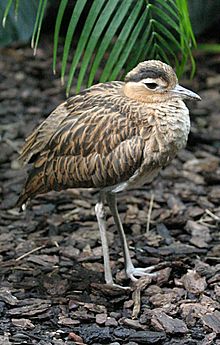- Double-striped Thick-knee
-
Double-striped Thick-knee 
At the Milwaukee County Zoological Gardens Conservation status Scientific classification Kingdom: Animalia Phylum: Chordata Class: Aves Order: Charadriiformes Family: Burhinidae Genus: Burhinus Species: B. bistriatus Binomial name Burhinus bistriatus
Wagler, 1829The Double-striped Thick-knee, Burhinus bistriatus, is a Stone-curlew, a group of waders in the family Burhinidae.
It is a resident breeder in Central and South America from southern Mexico south to Colombia, Venezuela and northern Brazil. It also occurs on Hispaniola and some of the Venezuelan islands, and is a very rare vagrant to Trinidad, Curaçao and the USA.
This is a largely nocturnal and crepuscular species of arid grassland, savanna, and other dry, open habitats. The nest is a bare scrape into which two olive-brown eggs are laid and incubated by both adults for 25-27 days to hatching. The downy young are precocial and soon leave the nest.
The Double-striped Thick-knee is a medium-large wader with a strong black and yellow bill, large yellow eyes, which give it a reptilian appearance, and cryptic plumage. The scientific genus name refers to the prominent joints in the long greenish-grey legs, and bistriatus to the two stripes of the head pattern.
The adult is about 46-50 cm long and weighs about 780-785 g. It has finely streaked grey-brown upperparts, and a paler brown neck and breast merging into the white belly. The head has a strong white supercilium bordered above by a black stripe. Juveniles are similar to adults, but have slightly darker brown upperparts and a whitish nape.
Double-striped Thick-knee is striking in flight, with a white patch on the dark upperwing, and a white underwing with a black rear edge. However, it avoids flying, relying on crouching and camouflage for concealment. The song, given at night, is a loud kee-kee-kee.
There are four subspecies, differing in size and plumage tone, but individual variation makes identification of races difficult.
The Double-striped Thick-knee eats large insects and other small vertebrate and invertebrate prey. It is sometimes semi-domestcated because of its useful function in controlling insects, and has benefited from the clearing of woodlands to create pasture.
References
- BirdLife International (2004). Burhinus bistriatus. 2006. IUCN Red List of Threatened Species. IUCN 2006. www.iucnredlist.org. Retrieved on 11 May 2006. Database entry includes justification for why this species is of least concern
- ffrench, Richard (1991). A Guide to the Birds of Trinidad and Tobago (2nd edition ed.). Comstock Publishing. ISBN 0-8014-9792-2.
- Hilty, Steven L (2003). Birds of Venezuela. London: Christopher Helm. ISBN 0-7136-6418-5.
- A guide to the birds of Costa Rica by Stiles and Skutch ISBN 0-8014-9600-4
- Shorebirds by Hayman, Marchant and Prater ISBN 978-0-395-60237-9
External links
- Double-striped Thick-knee videos on the Internet Bird Collection
- Photo-Medium Res; Article sunbirdtours
- Photo-High Res-(display); Article borderland-tours Photo2-(display)
- Double-striped Thick-knee photo gallery VIREO Photo-High Res
Categories:- IUCN Red List least concern species
- Burhinus
Wikimedia Foundation. 2010.

